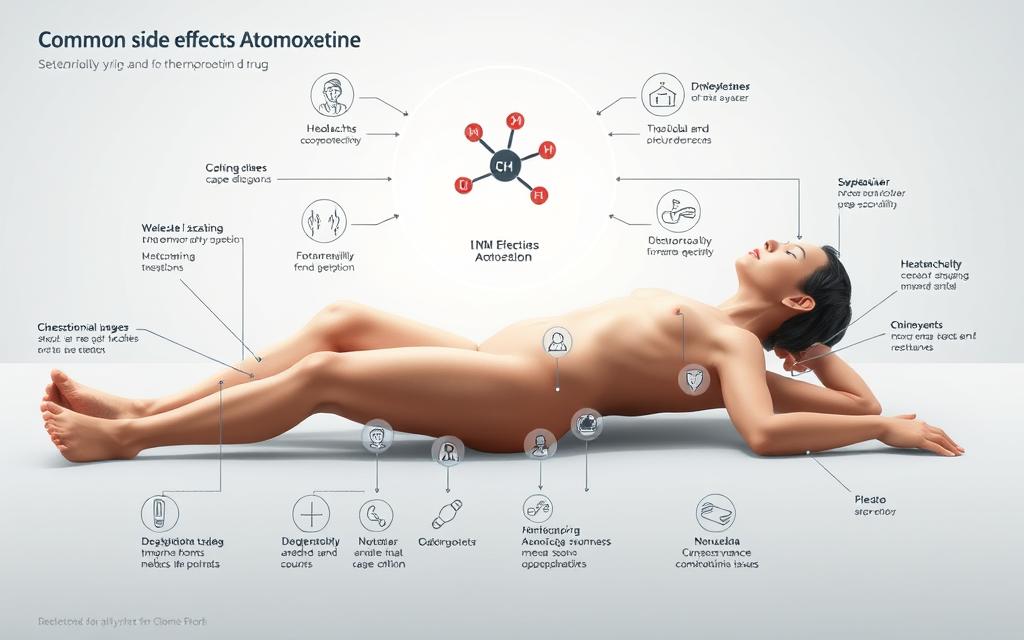Does Atomoxetine Cause Erectile Dysfunction? Side Effects & Sexual Health Explained
Atomoxetine is a medication commonly prescribed to treat Attention Deficit Hyperactivity Disorder (ADHD). It works by affecting certain chemicals in the brain that contribute to symptoms of ADHD.
While Atomoxetine is effective in managing ADHD symptoms, concerns have been raised about its potential impact on sexual health. One of the concerns is whether Atomoxetine can cause erectile dysfunction, a condition that affects a man’s ability to achieve or maintain an erection.
Understanding the relationship between Atomoxetine and sexual health is crucial for individuals considering this medication. Atomoxetine side effects can vary widely among individuals, and it’s essential to be aware of the potential risks and benefits associated with its use.
This article aims to provide a comprehensive overview of Atomoxetine’s impact on sexual health, including its potential to cause erectile dysfunction. By examining the available data and research, we hope to offer clarity on this important issue.
Understanding Atomoxetine: What It Is and How It Works
Atomoxetine, known for its application in ADHD treatment, works through a unique mechanism. It is primarily used to manage symptoms of Attention Deficit Hyperactivity Disorder (ADHD).
Primary Uses in ADHD Treatment
Atomoxetine is a non-stimulant medication approved for the treatment of ADHD in both children and adults. Its effectiveness in reducing symptoms such as inattention and hyperactivity makes it a valuable treatment option.
Mechanism of Action as a Norepinephrine Reuptake Inhibitor
Atomoxetine operates by selectively inhibiting the reuptake of norepinephrine, a neurotransmitter involved in attention and impulse control. This action enhances the availability of norepinephrine in the brain, thereby improving ADHD symptoms.
| Mechanism | Effect on ADHD Symptoms |
|---|---|
| Norepinephrine reuptake inhibition | Improves attention and reduces hyperactivity |
| Selective action on norepinephrine | Minimizes potential for abuse compared to stimulant medications |
Common Side Effects of Atomoxetine
The use of Atomoxetine for ADHD has been associated with various side effects, which can be categorized into non-sexual and sexual side effects.
Non-Sexual Side Effects
Atomoxetine can cause a range of non-sexual side effects. Common among these are nausea, headache, and fatigue. Some patients may also experience changes in appetite or sleep disturbances. It’s essential for patients to discuss these potential side effects with their healthcare provider to manage them effectively.
Sexual Side Effects Overview
Sexual side effects are a concern for many patients taking Atomoxetine. While the medication is not as commonly associated with sexual dysfunction as some other ADHD treatments, it can still impact sexual health.
Prevalence Rates in Clinical Studies
Clinical studies have provided insight into the prevalence of sexual side effects among Atomoxetine users. The data indicates that sexual dysfunction occurs but is relatively less common compared to other ADHD medications.

| Side Effect | Prevalence Rate |
|---|---|
| Nausea | 20% |
| Headache | 15% |
| Sexual Dysfunction | 5% |
Understanding these side effects can help patients and healthcare providers make informed decisions about treatment options.
The Science Behind Atomoxetine and Sexual Dysfunction
Understanding the relationship between Atomoxetine and sexual dysfunction requires a closer look at its mechanism of action. Atomoxetine is a norepinephrine reuptake inhibitor, which means it works by increasing the levels of norepinephrine in the brain.
How Norepinephrine Affects Sexual Function
Norepinephrine plays a significant role in attention and arousal. While its primary association is with alertness and ADHD symptom management, norepinephrine also influences sexual function. Research suggests that alterations in norepinephrine levels can impact sexual arousal and performance. Therefore, the modulation of norepinephrine by Atomoxetine could potentially affect sexual function.
Comparison with Other ADHD Medications
ADHD medications are broadly categorized into stimulants and non-stimulants. Atomoxetine falls into the non-stimulant category. The differences between these categories can influence their side effect profiles, including their impact on sexual health.
Stimulants vs. Non-Stimulants
Stimulant medications, such as Ritalin and Adderall, work by increasing dopamine and norepinephrine levels in the brain. Non-stimulants like Atomoxetine primarily affect norepinephrine. While both types can have side effects, their impact on sexual function can vary. Comparing these medication types is crucial for understanding the potential sexual side effects.
In conclusion, the science behind Atomoxetine and sexual dysfunction involves understanding its effect on norepinephrine and comparing it with other ADHD medications. This knowledge can help in managing potential sexual side effects.
Erectile Dysfunction and Atomoxetine: Clinical Evidence
Atomoxetine, a medication primarily used for ADHD, has been scrutinized for its potential impact on sexual health, particularly erectile dysfunction. The clinical evidence linking Atomoxetine to erectile dysfunction is a complex issue that requires careful examination.
Research Findings on Causation
Several studies have investigated the relationship between Atomoxetine and erectile dysfunction. Some research suggests that Atomoxetine may contribute to sexual dysfunction due to its mechanism of action as a norepinephrine reuptake inhibitor. However, the evidence is not conclusive, and more research is needed to fully understand this association.
- Studies have shown mixed results regarding the incidence of erectile dysfunction in patients taking Atomoxetine.
- The variability in findings may be attributed to differences in study populations and methodologies.
Risk Factors That May Increase Susceptibility
Certain factors may increase the risk of experiencing erectile dysfunction while taking Atomoxetine. Understanding these risk factors is crucial for managing potential sexual side effects.
Age and Pre-existing Conditions
Age is a significant factor, as older individuals may be more susceptible to the sexual side effects of Atomoxetine. Additionally, pre-existing medical conditions such as diabetes or hypertension can also increase the risk of erectile dysfunction.
- Older adults should be closely monitored for signs of sexual dysfunction.
- Patients with pre-existing conditions should discuss their individual risk factors with their healthcare provider.
By understanding the clinical evidence and risk factors associated with Atomoxetine and erectile dysfunction, healthcare providers can offer more informed guidance to patients. This knowledge can help in making informed decisions about treatment options and managing potential side effects.
Can Skipping Cure Erectile Dysfunction? Exercise and ED
Can skipping and other forms of exercise really help alleviate erectile dysfunction? The relationship between physical activity and sexual health is complex, but research suggests that exercise can have a positive impact on erectile dysfunction (ED).
Physical Activity and Sexual Health
Regular physical activity, such as skipping, improves cardiovascular health, which is closely linked to sexual function. Exercise helps to enhance blood flow, reduce inflammation, and improve overall vascular health, all of which are crucial for maintaining healthy erectile function.
Evidence-Based Approaches to Improving ED
Studies have shown that exercise can be an effective adjunct therapy for ED. Some evidence-based approaches include:
- Aerobic exercises like cycling, swimming, or skipping
- Resistance training to improve overall muscle strength
- Pelvic floor exercises, such as Kegel exercises, to strengthen the muscles involved in erection
By incorporating these exercises into their lifestyle, individuals can potentially improve their erectile function and overall sexual health.
Managing Sexual Side Effects While Taking Atomoxetine
Addressing sexual side effects in individuals taking Atomoxetine involves a combination of medical and lifestyle adjustments. For those experiencing these issues, it’s crucial to explore various strategies to mitigate them.
Dosage Adjustments and Timing Strategies
One approach to managing sexual side effects is through dosage adjustments. Consulting with a healthcare provider about altering the dosage or timing of Atomoxetine intake can help minimize its impact on sexual function. For instance, taking the medication at a different time of day may reduce side effects.
Lifestyle Modifications That May Help
Lifestyle changes can also play a significant role in alleviating sexual side effects. Regular physical activity, a balanced diet, and stress management techniques such as meditation or yoga can improve overall sexual health.

Complementary Treatments for Sexual Function
In some cases, complementary treatments may be beneficial. These can include counseling, certain supplements, or alternative therapies aimed at enhancing sexual function. It’s essential to discuss these options with a healthcare provider to determine the best course of action.
| Strategy | Description | Potential Benefit |
|---|---|---|
| Dosage Adjustment | Altering the dose or timing of Atomoxetine | Reduced sexual side effects |
| Lifestyle Modifications | Increasing physical activity, balanced diet, stress management | Improved overall sexual health |
| Complementary Treatments | Counseling, supplements, alternative therapies | Enhanced sexual function |
Alternative Medications for Those Experiencing Sexual Side Effects
Alternative ADHD medications may be necessary for individuals who experience sexual side effects while taking Atomoxetine. For those affected, exploring other treatment options can help mitigate these issues while maintaining effective ADHD management.
Other ADHD Treatment Options
Several alternative medications are available for treating ADHD, including:
- Methylphenidate-based medications, which work differently than Atomoxetine and may have a lower risk of sexual side effects.
- Non-stimulant medications like Guanfacine and Clonidine, which can be effective for some patients.
- Combination therapies that pair different medications to achieve optimal results with minimal side effects.
| Medication Type | Mechanism of Action | Sexual Side Effects Risk |
|---|---|---|
| Methylphenidate | Stimulant, increases dopamine and norepinephrine | Lower risk compared to Atomoxetine |
| Guanfacine | Non-stimulant, alpha-2 adrenergic agonist | Generally lower risk |
| Clonidine | Non-stimulant, alpha-2 adrenergic agonist | Generally lower risk |
Discussing Medication Switches with Your Doctor
If you’re experiencing sexual side effects from Atomoxetine, it’s essential to discuss your concerns with your doctor. They can help determine the best alternative treatment plan tailored to your needs.
Key points to discuss with your doctor include:
- The severity and impact of the sexual side effects you’re experiencing.
- Your medical history and any previous reactions to ADHD medications.
- The potential benefits and risks of alternative medications.
Conclusion: Balancing Effective ADHD Treatment and Sexual Health
Balancing ADHD treatment with sexual health is crucial for overall well-being. Atomoxetine, a commonly prescribed ADHD medication, can have varying effects on sexual function. While it is effective in managing ADHD symptoms, some individuals may experience sexual side effects, including erectile dysfunction.
Understanding the potential risks and benefits of atomoxetine is essential. By being aware of the possible sexual side effects and discussing them with a healthcare provider, individuals can make informed decisions about their treatment. Alternative ADHD medications and lifestyle modifications can also help mitigate sexual health issues.
Ultimately, achieving a balance between effective ADHD treatment and maintaining sexual health requires a comprehensive approach. By considering individual needs and exploring various treatment options, individuals can optimize their overall health and quality of life, leading to a more balanced and fulfilling life while managing ADHD.
